 |
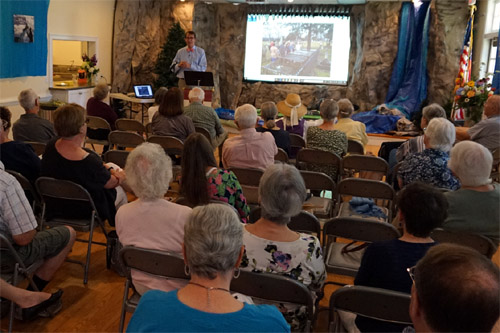 Jeffry Burden of the Friends of Shockoe Hill Cemetery speaks to HCHS members and guests at St. Paul's Episcopal Church.
|  |
On Sunday, June 23, 2019, Jeffry Burden of the Friends of Shockoe Hill Cemetery spoke to some 30 members of the Hanover County Historical Society and their guests, at St. Paul's Episcopal Church in Hanover Courthouse. Mr. Burden talked about the cemetery's history and its ties to Hanover County. Shockoe Hill Cemetery was established in 1820 with four acres of land on the edge of the city, and its first burial took place in 1822. It was Richmond's first city-owned municipal burial ground, and remains today an excellent example of an early 19th-century urban cemetery. John Marshall, 4th Chief Justice of the United States Supreme Court (and the longest-serving Chief Justice in history: 1801-1835) was buried here in 1835, which made Shockoe Hill Cemetery Richmond's fashionable burial ground in which to be interred. |
|
Others of historical note buried at Shockoe Hill Cemetery are 14th Governor of Virginia (and 6th Chief Justice of the Supreme Court) William Cabell (1752-1853); Revolutionary War hero Peter Francisco (1760-1831); and John M. Patton (1797-1858), who served as acting Governor of Virginia in 1841, and was the great-grandfather of famed US Army General George Patton.
Elizabeth Van Lew was an abolitionist from a wealthy Richmond family who led a spy ring in the capital of the Confederacy on behalf of the Union during the Civil War. Her efforts were much valued by the "boys in blue," but after the war Van Lew found herself shunned by Richmond society, many of whom viewed her as a traitor.
When she was buried in Shockoe Hill Cemetery in 1900, her grave was not marked, lest it be the target of retribution. Relatives of Union Colonel Paul J. Revere, whom Van Lew had assisted during the war, donated the boulder from Boston Common that marks her grave today. Many of the men and women who collaborated with Van Lew in her spy ring are also buried at Shockoe Hill Cemetery. |
 |
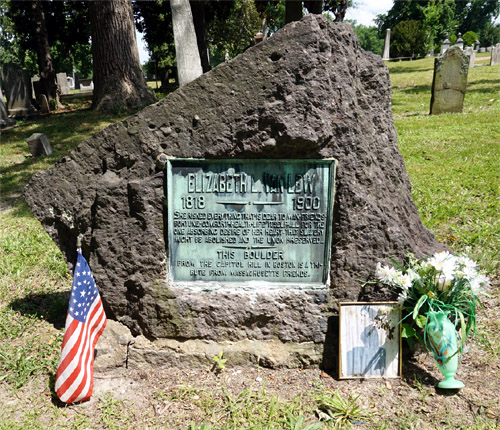
|
|
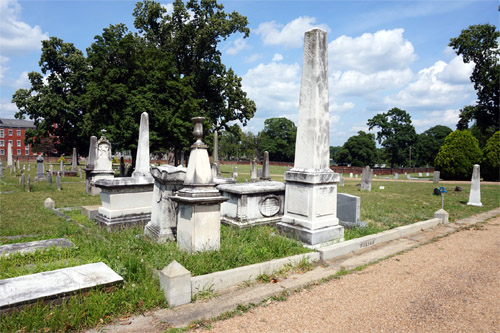 The Wickham family plot.
|  |
Also seen at Shockoe Hill Cemetery is name familiar to many Hanoverians: Wickham. John Wickham, born in the colony of New York in 1763, was an American Loyalist who moved to Richmond after the Revolutionary War, got a law degree at the College of William and Mary, and successfully practiced law, occasionally in a courtroom over which his friend John Marshall presided. Wickham was lead counsel in the defense Aaron Burr in his trial for treason in 1807. John Wickham was buried at Shockoe Hill Cemetery in 1839. Also buried in this plot are two of General Robert E. Lee's short-lived grandchildren, Charlotte Carter Lee and Robert E. Lee III. John Wickham was the grandfather of Hanover's own Williams Carter Wickham, Confederate cavalry officer and Virginia statesman during and after the Civil War, whose hereditary home was Hickory Hill. |
|
Shockoe Hill Cemetery has expanded since its inception, and now covers nearly thirteen acres: Close to 22,000 people are buried therein. This large number was made possible by the old-time practice of "stacking" up to eight coffins atop one another. All of the cemetery's plots were occupied by 1900, but a small number of unused plots have been recently reclaimed, and are presently available to the public.
 A large part of the cemetery's northeast section seems deceptively empty: There are hundreds of unmarked graves of Confederate and Union soldiers.
|  |
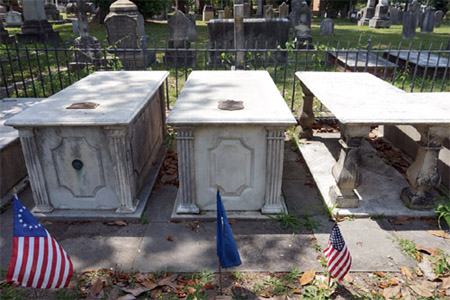 Chief Justice John Marshall is in the center:
His wife Mary (who was known as Polly) is to the right.
|
|
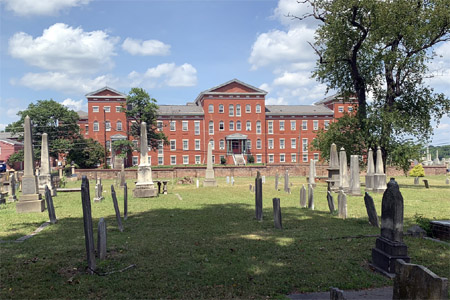
|  |
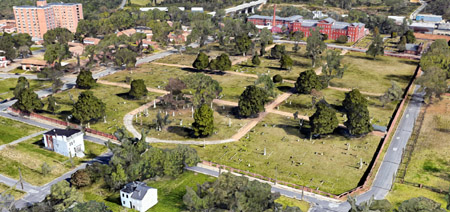 Shockoe Hill Cemetery from the southeast.
Left: Across Hospital Street from the cemetery is Shockoe Hill Apartments I, which was originally the Alms House, built in the 1850's. It served as a hospital during the Civil War (which is the reason for all the Confederate and Union dead in the cemetery), and after the Virginia Military Institute in Lexington, Virginia was destroyed by the Union in June of 1864, VMI cadets used this building as a barracks, and to continue classes.
|
|
|
|
|  |


